八年级英语下册-Unit5--Section-A-(3a-3c)教学设计
- 格式:doc
- 大小:30.50 KB
- 文档页数:4
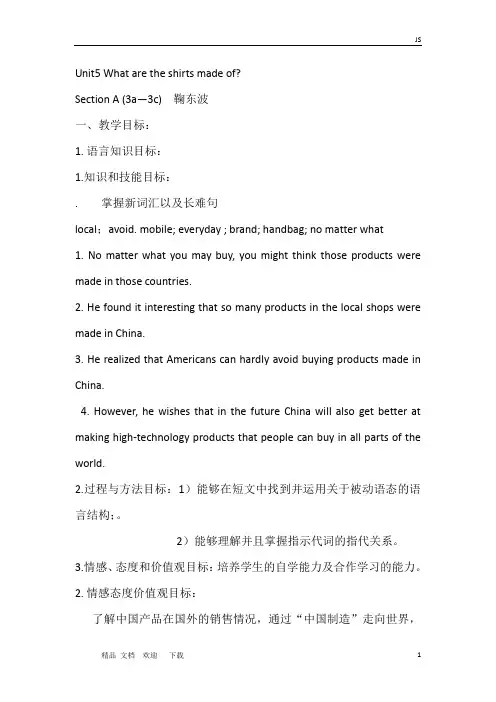
Unit5 What are the shirts made of?Section A (3a—3c) 鞠东波一、教学目标:1. 语言知识目标:1.知识和技能目标:. 掌握新词汇以及长难句local;avoid. mobile; everyday ; brand; handbag; no matter what1. No matter what you may buy, you might think those products were made in those countries.2. He found it interesting that so many products in the local shops were made in China.3. He realized that Americans can hardly avoid buying products made in China.4. However, he wishes that in the future China will also get better at making high-technology products that people can buy in all parts of the world.2.过程与方法目标:1)能够在短文中找到并运用关于被动语态的语言结构;。
2)能够理解并且掌握指示代词的指代关系。
3.情感、态度和价值观目标:培养学生的自学能力及合作学习的能力。
2. 情感态度价值观目标:了解中国产品在国外的销售情况,通过“中国制造”走向世界,培养学生的民族自豪感及爱国主义精神。
二、教学重难点1. 教学重点:1) 掌握本课时中出现的新词汇;2) 用被动语态描述产物及产地;3)正确理解被动语态的用法及句子结构。
2. 教学难点:理解被动语态的用法及句子结构。
学情分析学生们经过第一节课的学习对被动语态有了初步的理解和认识,本节课通过合作学习及相关练习,学生对这一结构会有更透彻的理解和运用。
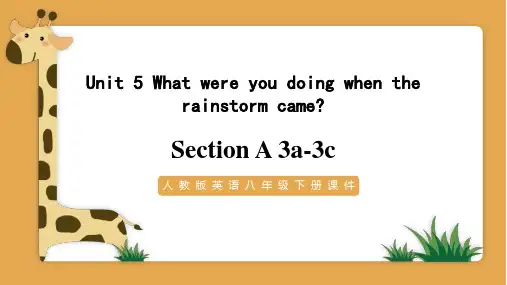
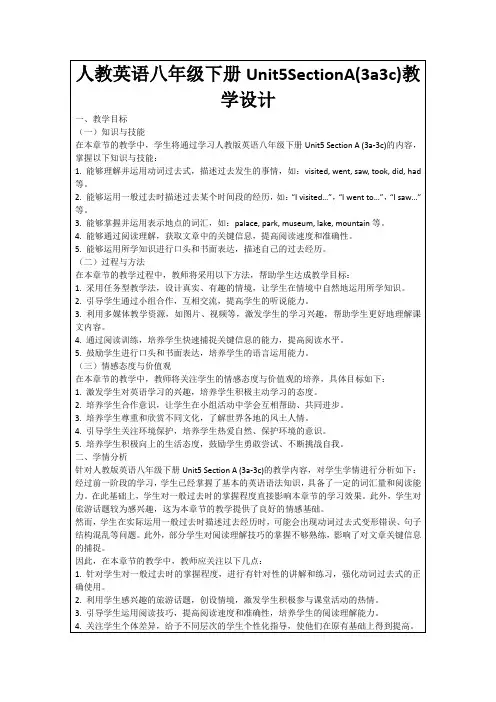
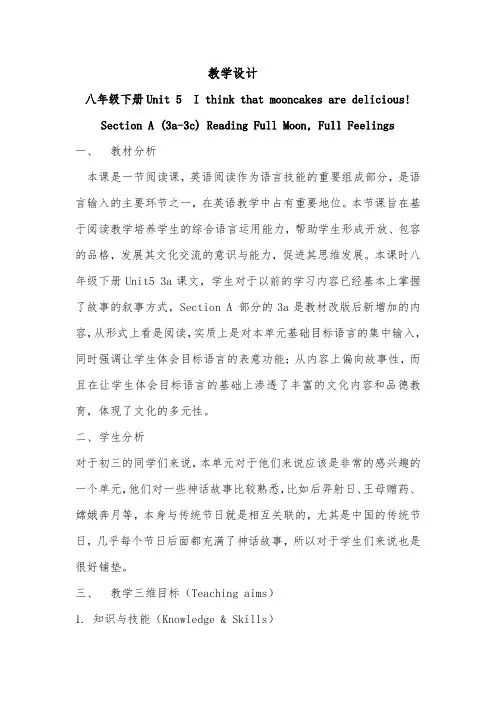
教学设计八年级下册Unit 5 I think that mooncakes are delicious!Section A (3a-3c) Reading Full Moon, Full Feelings一、教材分析本课是一节阅读课,英语阅读作为语言技能的重要组成部分,是语言输入的主要环节之一,在英语教学中占有重要地位。
本节课旨在基于阅读教学培养学生的综合语言运用能力,帮助学生形成开放、包容的品格,发展其文化交流的意识与能力,促进其思维发展。
本课时八年级下册Unit5 3a课文,学生对于以前的学习内容已经基本上掌握了故事的叙事方式,Section A 部分的3a是教材改版后新增加的内容,从形式上看是阅读,实质上是对本单元基础目标语言的集中输入,同时强调让学生体会目标语言的表意功能;从内容上偏向故事性,而且在让学生体会目标语言的基础上渗透了丰富的文化内容和品德教育,体现了文化的多元性。
二、学生分析对于初三的同学们来说,本单元对于他们来说应该是非常的感兴趣的一个单元,他们对一些神话故事比较熟悉,比如后羿射日、王母赠药、嫦娥奔月等,本身与传统节日就是相互关联的,尤其是中国的传统节日,几乎每个节日后面都充满了神话故事,所以对于学生们来说也是很好铺垫。
三、教学三维目标(Teaching aims)1. 知识与技能(Knowledge & Skills)(1)理解并会运用单词 admire、goddess、 steal、lay out、dessert;(2)通过故事发展的顺序寻找关键词;(3)通过关键词与他人合作讲述故事,并正确使用一般过去时;2. 过程与方法(Process & Steps)(1)利用字里行间的意义来拓展文本内容,赏析文学作品之美;(2)熟悉阅读策略,如寻读、找关键词、理解大意、了解重点细节、评价阅读内容;3.情感态度价值观(Emotional Attitude & Values)(1)了解文本故事的起源和节日习俗;(2)培养批判性的阅读思维能力,培养爱国意识,弘扬民族精神。
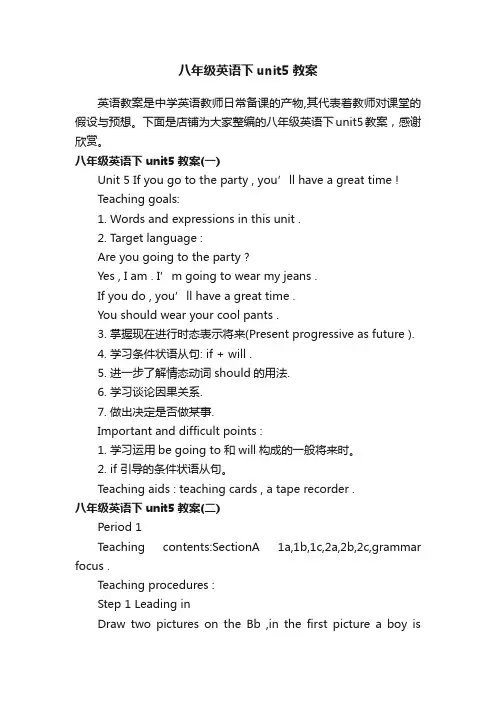
八年级英语下unit5教案英语教案是中学英语教师日常备课的产物,其代表着教师对课堂的假设与预想。
下面是店铺为大家整编的八年级英语下unit5教案,感谢欣赏。
八年级英语下unit5教案(一)Unit 5 If you go to the party , you’ll have a great time !Teaching goals:1. Words and expressions in this unit .2. Target language :Are you going to the party ?Yes , I am . I’m going to wear my jeans .If you do , you’ll have a great time .You should wear your cool pants .3. 掌握现在进行时态表示将来(Present progressive as future ).4. 学习条件状语从句: if + will .5. 进一步了解情态动词should的用法.6. 学习谈论因果关系.7. 做出决定是否做某事.Important and difficult points :1. 学习运用be going to 和will构成的一般将来时。
2. if 引导的条件状语从句。
Teaching aids : teaching cards , a tape recorder .八年级英语下unit5教案(二)Period 1Teaching contents:SectionA 1a,1b,1c,2a,2b,2c,grammar focus .Teaching procedures :Step 1 Leading inDraw two pictures on the Bb ,in the first picture a boy isgetting up late ,and in the second picture the boy can’t catch the early bus .Then talk about the pictures with Ss and write down the sentence “If you get up late , you will not catch the early bus .”Read the sentences ,Ss repeat .Repeat with other sets of pictures .Step 2 Pre-taskSB Page 34 , 1a .1. Point out the pictures and ask Ss to tell what they see .2. Ask some students to read the statements and responses .3. Have Ss match the statements and responses on their own .Step 3 While-taskSB Page 34 , 1b .1. Play the tape and get Ss to check their answers to activity 1a .2. Talk about the answers together .SB Page 34 , 1c .1. Ask two Ss to read the example in the sample in activity 1c.2. In pairs , get Ss to talk about what happened in the pictures .3. Ask some pairs to present their conversations to the class .SB Page 35 , 2a & 2b .1. Read the instructions .Make sure the students know what to do .2. Play the recording .Ss listen and write down their answers .3. Correct the answers .Step 4 Post-taskSB Page 35 , 2c .1. Ask two students to read the sample dialogue .2. In pairs ,get the students to role play the conversation between Andrea and her friend .3. Ask a few pairs of students to practice their conversations for the class .Step 5 Grammar FocusSB Page 35 , Grammar Focus .1. Review the grammar focus .Ask Ss to say the statements and responses .2. Ask Ss to work in small groups .Ask each group to write down as many sentences like those in the grammar focus as they can.3. Ask some groups to share their sentences with the class .Homework :Have Ss write their sentences on their exercise books.教学后记:八年级英语下unit5教案(三)Period 2Teaching contents: SectionA 3a,3b,4,SectionB 1,2a,2b,2c.Teaching procedures:Step 1 Leading inAsk some students to make sentences with if .Step 2 Pre-taskSB Page 36 , 3a .1. First ,let Ss read the notice from the principal .2. Read the dialogue to the class saying bland when come toa blank line .3. Get Ss read the notice again and fill in the blanks .4. Correct the answers .Step 3 While-taskSB Page 36 , 3b .1. Ask some students to read out the sample dialogue and the words in the box .2. In pairs , let Ss have a conversation about the rules .3. Get some pairs to say their conversations to the class .SB Page 36 , Part 4 .1. Read the instructions and ask Ss to complete the work in pairs .2. Ask a few students to share their conversations .Step 4 Post-taskSB Page 37 , Part 1 .Ask students to complete the work on their own .Then do a quick check to see which things are most important to students in the class .SB Page 37 , 2a & 2b .1. Read the instructions and play the recording .2. Ss listen and write down their answers .3. Correct the answers .SB Page 37 , 2c .In pairs , get Ss to role play a conversation according to the information in activity 2b .Homework:Have Ss write their conversations on their exercise books.教学后记:。
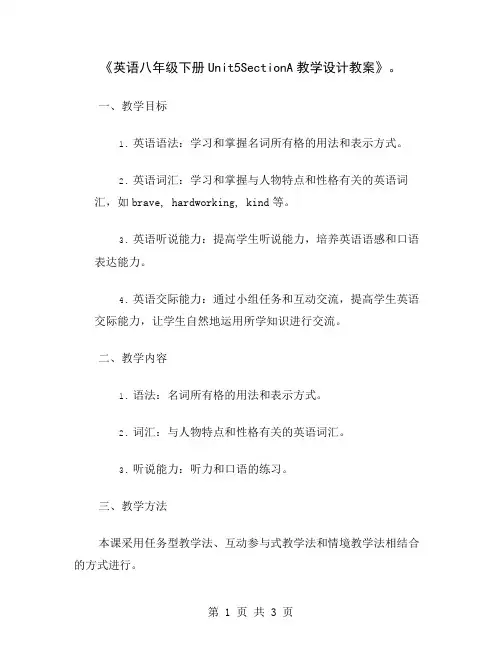
《英语八年级下册Unit5SectionA教学设计教案》。
一、教学目标1.英语语法:学习和掌握名词所有格的用法和表示方式。
2.英语词汇:学习和掌握与人物特点和性格有关的英语词汇,如brave, hardworking, kind等。
3.英语听说能力:提高学生听说能力,培养英语语感和口语表达能力。
4.英语交际能力:通过小组任务和互动交流,提高学生英语交际能力,让学生自然地运用所学知识进行交流。
二、教学内容1.语法:名词所有格的用法和表示方式。
2.词汇:与人物特点和性格有关的英语词汇。
3.听说能力:听力和口语的练习。
三、教学方法本课采用任务型教学法、互动参与式教学法和情境教学法相结合的方式进行。
四、教学过程1.小组活动:给学生们分一个小组,让他们自己组织并开展活动,让同学们互相交流,并相互帮助。
2.课堂讲授:在课堂上向学生讲解名词所有格的用法和表示方式,让学生理解和记住相应的知识点。
3.听力和口语训练:让学生通过听力训练和口语练习,提高他们的英语听说能力和表达能力,加深他们对英语语言的理解和应用。
五、教学评估1.小组任务:让学生们组队开展任务,将他们所学知识运用到生活中,然后让他们向全班汇报。
这有助于他们巩固知识点,加深理解。
2.口语表达:在教学过程中我们将注重引导学生的口语表达能力,让学生积极参与课堂互动和口语练习,根据学生的发音、流利程度、词汇运用方式等标准进行评估。
六、教学反思通过本次课的教学,学生们已经能够熟练掌握名词所有格的运用,以及与人物特点和性格相关的英语词汇。
同时,由于我们采用了任务型教学、互动参与式教学和情境教学相结合的方式,学生们也能够自由交流,加深对英语语言的理解和应用。
然而,我认为在今后的教学中,我们仍需要进一步完善学生的英语听说技能,让他们更加自然地运用英语,提高他们的英语表达能力和口语流利程度。
此外,我们也可以采用英语角和阅读小组等活动形式,让学生更好地接触英语,丰富他们的语言知识和文化背景,让英语教育更加生动、有趣,更深受学生欢迎。
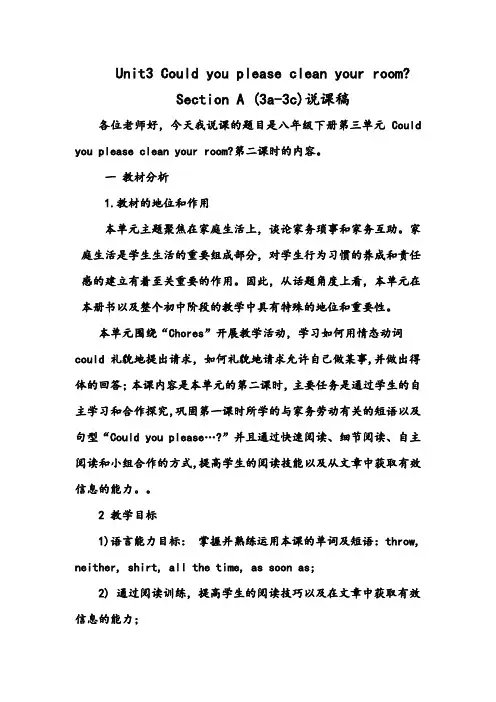
Unit3 Could you please clean your room?Section A (3a-3c)说课稿各位老师好,今天我说课的题目是八年级下册第三单元Could you please clean your room?第二课时的内容。
一教材分析1.教材的地位和作用本单元主题聚焦在家庭生活上,谈论家务琐事和家务互助。
家庭生活是学生生活的重要组成部分,对学生行为习惯的养成和责任感的建立有着至关重要的作用。
因此,从话题角度上看,本单元在本册书以及整个初中阶段的教学中具有特殊的地位和重要性。
本单元围绕“Chores”开展教学活动,学习如何用情态动词could 礼貌地提出请求,如何礼貌地请求允许自己做某事,并做出得体的回答;本课内容是本单元的第二课时,主要任务是通过学生的自主学习和合作探究,巩固第一课时所学的与家务劳动有关的短语以及句型“Could you please…?”并且通过快速阅读、细节阅读、自主阅读和小组合作的方式,提高学生的阅读技能以及从文章中获取有效信息的能力。
2 教学目标1)语言能力目标:掌握并熟练运用本课的单词及短语:throw, neither, shirt, all the time, as soon as;2) 通过阅读训练,提高学生的阅读技巧以及在文章中获取有效信息的能力;3)文化意识和思维品质:让学生体会父母的辛苦。
热爱父母,主动帮助承担家务。
3 教学重点和难点通过阅读训练,提高学生的阅读技巧以及在文章中获取有效信息的能力;二学生学情分析八年级的学生有了一定的英语学习基础,有一定的合作交流能力,不善于表达自己的观点和看法,语言表达能力和逻辑思维能力不强。
虽然学生从学习英语开始,就接触英语阅读,但是在阅读的过程中还有一些学生不懂阅读技巧和阅读方法,在阅读过程中会走进误区。
只有通过英语课上教给学生正确的阅读技巧和方法,培养学生的阅读理解能力,慢慢提高和渗透,以及从文章中获取有效信息的能力。
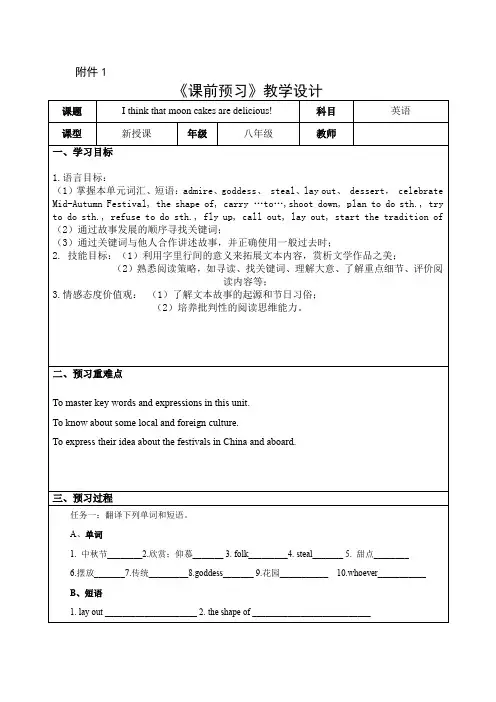
附件1《课前预习》教学设计3. shoot down _____________________4. fly up _________________________5. call out ___________________6. 努力去做某事___________________________7. 打算;计划做某事__________________ 8. 拒绝去做某事_____________________9. 如此…以至于…. _______________ 10. 开始…的传统__________________________任务二:预习3a,翻译下列句子。
1.月饼是中秋之夜满月的形状。
_____________________________________________________________________2. 然而,大多数人认为嫦娥的故事是最感人的。
_____________________________________________________________________3.无论谁喝了此药便能长生不老,后羿打算和嫦娥一起服用。
___________________________________________________________________4.后羿悲痛不已,以至于每晚都对着月亮大声呼喊她的名字。
_____________________________________________________________________备注:对话中你不理解的句子是:_____________________________________________________________________四、预习诊断1. I invited him to have a meeting but he refused_____(come).2.嫦娥的故事是最感人的。
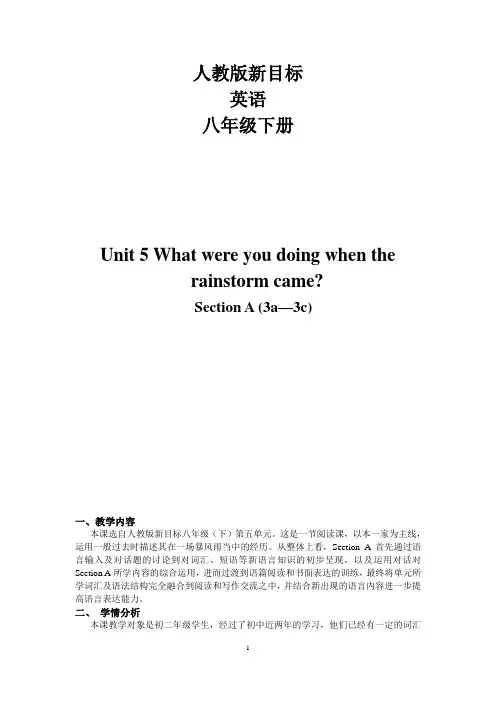
人教版新目标英语八年级下册Unit 5 What were you doing when therainstorm came?Section A (3a—3c)一、教学内容本课选自人教版新目标八年级(下)第五单元。
这是一节阅读课,以本一家为主线,运用一般过去时描述其在一场暴风雨当中的经历。
从整体上看,Section A 首先通过语言输入及对话题的讨论到对词汇、短语等新语言知识的初步呈现,以及运用对话对Section A所学内容的综合运用,进而过渡到语篇阅读和书面表达的训练,最终将单元所学词汇及语法结构完全融合到阅读和写作交流之中,并结合新出现的语言内容进一步提高语言表达能力。
二、学情分析本课教学对象是初二年级学生,经过了初中近两年的学习,他们已经有一定的词汇积累,并具备了基本的阅读理解能力。
本班学生学习英语兴趣较浓,学习程度相对较好。
学生在Section A前半部分已经基本掌握过去进行时的表达方法,在篇章中理解和运用过去进行时以及描述过去发生的事情是本课的重点,且关于暴风雨的经历学生在实际生活中较为缺乏,因此要在教学中给学生创设出情景,鼓励他们表达。
三、教学目标:1.知识目标a. 学生能够熟练掌握教材中的“四会”单词、词组:wind, apart, wood, light, flashlights, candles, matches, die down。
b. 学生能够熟悉并正确运用过去进行时。
2.能力目标a. 学生能够运用过去进行时谈论文本中出现的活动b. 通过阅读训练,学生能够学会寻找中心句,利用scanning和skimming的阅读技巧提取语篇的重点信息。
3.情感目标a. 通过本课的学习,学生能够养成在危难中互帮互助的精神。
四、教学重难点1. 教学重点:a. 培养学生在英语阅读中获取信息的能力,提高阅读的效率。
b. 熟悉并运用过去进行时。
2. 教学难点:a. 通过阅读训练,培养学生在英语阅读中获取信息的能力,提高阅读的效率。
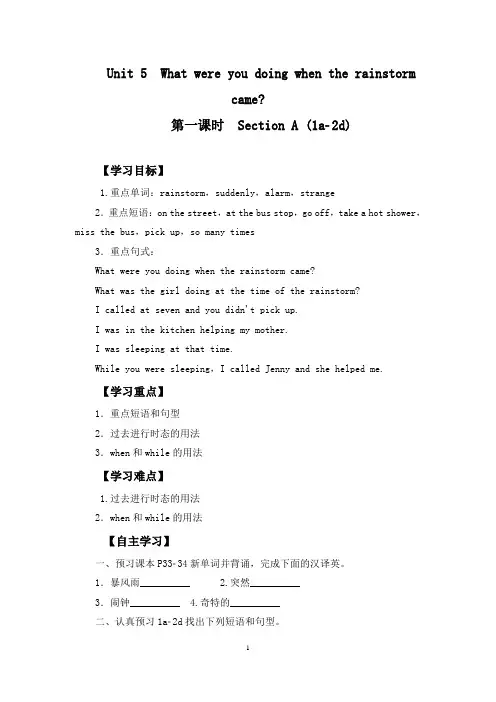
Unit 5 What were you doing when the rainstormcame?第一课时Section A (1a2d)【学习目标】1.重点单词:rainstorm,suddenly,alarm,strange2.重点短语:on the street,at the bus stop,go off,take a hot shower,miss the bus,pick up,so many times3.重点句式:What were you doing when the rainstorm came?What was the girl doing at the time of the rainstorm?I called at seven and you didn't pick up.I was in the kitchen helping my mother.I was sleeping at that time.While you were sleeping,I called Jenny and she helped me.【学习重点】1.重点短语和句型2.过去进行时态的用法3.when和while的用法【学习难点】1.过去进行时态的用法2.when和while的用法【自主学习】一、预习课本P3334新单词并背诵,完成下面的汉译英。
1.暴风雨__________ 2.突然__________3.闹钟__________ 4.奇特的__________二、认真预习1a2d找出下列短语和句型。
1.在街上2.在公共汽车站3.洗热水澡4.错过汽车5.接电话6.这么多次7.暴风雨来临的时候你正在做什么?8.我七点打了电话,但是你没有接。
9.我在厨房给我妈妈帮忙。
10.我那时在睡觉。
11.当你睡觉的时候,我给Jenny打了电话,她帮助了我。
【课堂导学】Step 1情景导入The teacher points at a girl in the classroom and asks:Teacher:Where are you?Student 1:I am in the classroom...Teacher:What are you doing?Student 1:I am answering your questions.The teacher writes “What are you doing?”on the blackboard and asks in Chinese:这是什么时态?引导学生回答,复习现在进行时态的意义及结构。
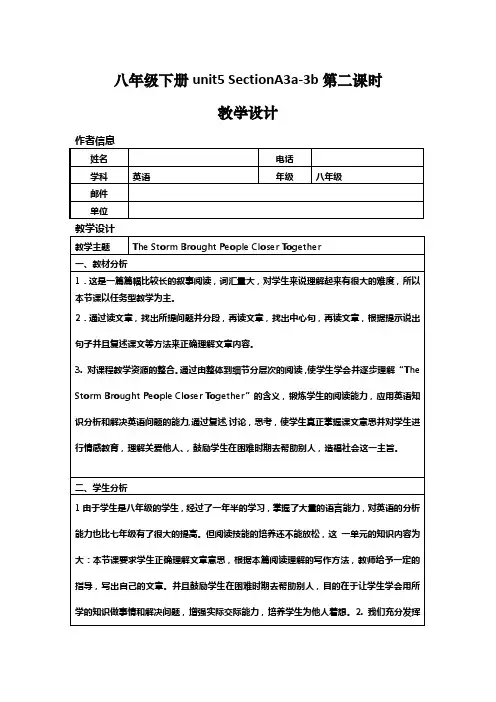
八年级下册unit5 SectionA3a-3b第二课时教学设计新目标六三制初中英语八年级下册Unit5sectionA3a-3b第二课时学情分析本学期我担任八年级英语教学工作,就近段时间对学生的了解来看,学生的总体水平不低,但也从教学中发现了不少问题。
现将学生的英语学习情况分析如下:八年级的学生性格特点是活泼好动,参与活动的热情会较高。
面对可塑性很强的学生,作为英语教师,我们一定要保护他们对英语学习的热情。
认知特点分析:学生已经学过过去进行时,本单元第一课时的学习也帮助学生对过去进行时有了初步的感知,学生理解上相对容易。
根据学生的心理特点我们一改以往教学生时的教学模式,课上多以表扬为主,注重对学生英语学习兴趣的培养,鼓励他们大胆说、积极做、努力尝试!让学生们在玩玩、做做、说说、谈谈中学习英语。
但这个年级的学生在学习方法和学习策略上还有待提高,尤其在答题技巧和技能方面还缺少锻炼。
因此本学期在实施英语教学的过程中,我和上学期一样在教授学生新知的同时更重视对学生学习方法和答题技巧的培养。
我一心争取在本学期让学生的学习能力和应试能力在原有的基础上能大幅度提高。
除以上所说的几种情况之外,八年级个别学生还存在顽劣和懒惰倾向,上课爱搞小动作、课下作业完成不及时的坏毛病,学习效率也较差。
针对这种情况我采取趣味教学的模式课上多为学生创设习得语言的环境,尽最大努力吸引学生的注意力以便更有交地激发他们的学习兴趣,而且课后老师经常找机会和他们聊天、交朋友,帮助他们转变厌学思想。
老师针对学生现状,在课堂上尽量以鼓励表扬为主,注重培养学习英语的兴趣,营造英语氛围,鼓励学生开口说英语、特别是给差生创造机会,让他们尝试成功的喜悦。
新目标六三制初中英语八年级下册Unit5 sectionA3a-3c第二课时效果分析通过free talking直接导入本节内容,直奔导入新课,简洁明了。
一.学生当堂对课文进行了多次阅读,并让学生仔细品读文章每一段落,总结概括大意并完成句子,锻炼学生的阅读能力,应用英语知识分析和解决英语问题的能力。
初中英语八年级下册Unit5 Section A 3a-3cUnit 5 I think that mooncakes are delicious!----教学设计一、教学目标知识与能力:1. 识记并运用下列单词:Folk,goddess,whoever,steal,lay,dessert,garden,tradition2.理解并运用短语:In the shape of,traditional folk stories,the most touching,live forever,shoot down,steal the medicine,call out,admire the moon,share...with3.掌握下列句型:1)However,most people think that the story of Chang’e is the mosttouching.2) One night,he found that the moon was so bright and round that he couldsee his wife there.3)How he wished that Chang’e could come back!过程与方法:能用一般过去时态讲述嫦娥奔月的故事。
情感态度与价值观:体会中秋节的内涵,学会珍惜现有的幸福生活。
二、教学重难点:本节课的单词短语以及出现的宾语从句及感叹句。
三、教学过程:(一)、情境引入:Let’s listen:A beautiful song about moon.(设计意图:活跃课堂气氛,使学生快速进入到英语思维。
激发学生学习英语的兴趣。
同时歌曲内容与本课新知有关,通过听音乐,舒缓学生情绪,增加自信心。
)(二)、质疑互辩【知识回顾】: 你能写出下列节日名称吗?中秋节___________泼水节________端午节___________ 元宵节_______【课前预习探索新知】Task1: 1.请同学们预习P35单词,小组合作、组长检查,确认读音准确。
人教版英语八年级下册教案:Unit5 SectionA(3a-4c)Unit5 SectionA(3a-4c)名师教案1.0Teaching analysis教情分析1.1Teaching objectives 教学目标1.1.1Language goals 语言目标1.1.1.1Key Words and Chunks1.1.1.1.1For applying: storm, wind, light, report, area, wood,window, match, beat, against, asleep, rise, fallen, icy,kid, feel like, in the area, beat against, at first, fallasleep, die down, in a mess, wake up, make sure, intimes of, right away, have a look, in bad shape1.1.1.1.2For comprehending: flashlight, apart, Alabama1.1.1.2Sentence Structures1)With no light outside, it felt like midnight.2)After dinner, they tried to play a card game, but it was hard to have fun with a serious storm happening outside.3)Although the storm broke many things apart, it brought families and neighbors closer together.4)He finally fell asleep when the wind was dying down at around 3:00 a.m.5)How can we help each other in times of difficulty?1.1.1.3Grammar Focus1)Black clouds were making the sky very dark. (过去进行时描述过去某个时刻正在发生的动作或存在的状态,结构是“was/were+现在分词”)2)Ben’s dad was putting pieces of wood over the windows while his mom was making sure the flashlights and radio wereworking. (while 表示“当……时候,与……同时”,引导时间状语从句,从句多用进行时态,主句多用一般过去时或过去进行时。
Unit 5 What were you doing when the rainstorm came?Section A (3a-3c)Teaching aims(教学目标):1.words,phrases and sentences.Words: storm wind light report wood window match beat against asleep rise fallenSentences:when和while引导的句子。
2. 能够理解过去进行时态在文章中的运用。
(重点):1. 要求掌握以下句式:(1) What were you doing when the rainstorm came?(2) Ben’s dad was putting pieces of wood over the windows while his mom was making sure …2.要求掌握以下词汇:(1)动词:report, beat, rise (v. & n.)(2)名词:storm, wind, light, area, wood, window, flashlight, matches, candle(3)副词:apart(4) 形容词:asleep, serious, fallen, broken(5) 介词:against(6) 词组:die down, fall asleep, break (sth.) apart, bring (sth.) closer together(本节课的生词在之前的学习中都已接触过,而且单词的拼写比较简单,所以学生学起来不会感到困难,如果班级学生的水平较高,可以鼓励学生当堂掌握。
Difficulties(难点):理解文中过去进行时的运用。
Teaching steps(教学步骤):1. Revision(复习)T: Yesterday, we learnt about was/were+Ving,Let’s review:Free talk::Look at the picture and practice with the sentences They were …when the rainstorm came.Have a picnicFly kitesClimb mountains(先给出短语,让学生一起逐个翻译,关注学生的反应,运用所给出的句型练习,巩固上节课学习的内容。
《新版英语八年级下册Unit5SectionA教学指南教案》。
一、教学目标1.掌握并运用本节课所学的动词短语;2.能够运用所学的动词短语,描述自己和他人的兴趣爱好;3.通过听、说、读、写等多种方式,提高学生的英语综合能力。
二、教学重点本节课的教学重点是掌握并运用所学的动词短语,如“go skiing”、“play basketball”、“listen to music”等,提高学生的英语交际能力,培养学生的听、说、读、写等多种语言技能。
三、教学难点本节课的难点是如何通过运用所学的动词短语,精确地描述自己和他人的兴趣爱好,加深学生对英语交际的理解和认识,提高学生的英语交流能力。
四、教学方法和手段本节课要采用多种教学方法和手段,如听力训练、口语训练、阅读训练和笔头训练等,使学生在不同的语言环境中进行综合性的语言实践,以提高学生的英语综合能力。
五、教学内容安排本节课的教学内容安排如下:1.复习上节课学过的内容,帮助学生们巩固所学;2.引导学生学习本节课所要掌握的动词短语,帮助学生们理解并记忆所学内容;3.进行听力训练,帮助学生们提高听力技能;4.进行口语训练,练习运用所学内容进行日常交流;5.进行阅读训练,帮助学生们提高阅读理解能力;6.进行笔头训练,帮助学生们提高英语书写能力。
六、教学方法和实践为帮助老师们更好地理解本节课的教学方法和实践,下面将对每一项具体内容进行阐述:1.复习上节课学过的内容本节课的复习内容应该包括上节课所学的重点知识点,如动词的时态、形式等,帮助学生们巩固记忆并理解所学识。
2.引导学生学习本节课所要掌握的动词短语本节课所要掌握的动词短语应该通过看图识词的方法进行引导学生学习,同时要结合实际情况,让学生通过图片和实物来理解和记忆所学内容。
3.进行听力训练听力训练是英语学习过程中必不可少的一环,能够有效提高学生的听力技能和理解能力。
在听力训练过程中,应该根据学生的实际情况调整训练难度,逐渐提高难度,帮助学生们适应英语听力的速度和语音。
Section A 第二课时(3a~4c)原创不容易,为有更多动力,请【关注、关注、关注】,谢谢!玉壶存冰心,朱笔写师魂。
——冰心《冰心》类别学习重点重点单词storm, wind, light, report, area, wood, window, match, beat, fallen, against,rise, asleep, icy, kid重点短语fall asleep, die down, make sure, at first, have a look重点句式1.With no light outside, it felt like midnight.2.When he woke up, the sun was rising.3.He finally fell asleep when the wind was dying down around 3:00 a.m.课前预习写一写1.暴风雨storm2.风wind3.光;光线;光亮light4.报道;公布report5.地域;地区area6.木;木头wood7.窗;窗户window8.火柴match9.敲打;打败beat 10.倚;碰;撞against 11.睡着asleep12.升起;增加;提高rise 13.倒下的;落下的fallen14.覆盖着冰的;冰冷的icy 15.开玩笑;欺骗kid译一译1.起初;起先at first2.进入梦乡;睡着fall asleep3.看一看have a look4.确保make sure背一背1.外面没有亮光,感觉就像半夜一样。
With no light outside, it felt like midnight.2.大约凌晨3点风逐渐变弱时他终于睡着了。
He finally fell asleep when the wind was dying down around 3:00 a.m.新课导入Teacher:Have you seen the storm? What is the neighborhood like after the storm? Nowlet’s read the passage in 3a to find the answers.新课展示新课展示【完成教材3a~3b的教学任务】1.快速阅读短文,找出老师提问的两个问题的答案,完成后让学生展示答案,教师点拨。
Unit 5 What were you doing when the rainstorm came?The Second Period: Section A (3a-3c)Teaching aims(教学目标):1.掌握运用阅读技巧skimming和scanning来获取信息;2. 能够理解过去进行时态在文章中的运用。
Key points (重点):1. 要求掌握以下句式:(1) What were you doing when the rainstorm came?(2) Ben’s dad was putting pieces of wood over the windows while hismom was making sure …2.要求掌握以下词汇:(1)动词:report, beat, rise (v. & n.)(2)名词:storm, wind, light, area, wood, window, flashlight, matches, candle(3)副词:apart(4) 形容词:asleep, serious, fallen, broken(5) 介词:against(6) 词组:die down, fall asleep, break (sth.) apart, bring (sth.) closer together(本节课的生词在之前的学习中都已接触过,而且单词的拼写比较简单,所以学生学起来不会感到困难,如果班级学生的水平较高,可以鼓励学生当堂掌握。
Difficulties(难点):理解文中过去进行时的运用。
Teaching steps(教学步骤):1. Revision(复习)T: Yesterday, we learnt some important phrases, let’s review them now! Please translate the following expressions.1.在…时候at the time of2.等公交wait for the bus3.(闹钟)响go off4.洗个热水澡take a hot shower5.错过公交miss the bus6.雨下得很大rain heavily7.接电话pick up / answer the call8.昨天很多人都遭遇了暴风雨。
Many people were caught in the rainstorm yesterday.(先给出汉语,让学生一起逐个翻译,关注学生的反应速度及流利程度,把掌握没到位的短语重新板书在黑板上,强调)教学设计说明:复习是为了巩固上节课所学内容,以词块翻译的形式,兼顾单词的用法,又没有句子那么复杂,减轻学生畏难情绪,并有助于学生语感的形成。
2. Lead-in(新课导入)T: In summer, there are always storms, right? And the storms always bring us some problems . Look at the pictures on the screen. What can you see?S1: In the first picture, the wind is strong and the rain is heavy .T: So what is it?S1: It is a storm.T: Yes. What happened to the trees?S2: Some trees have fallen.T: Yes. The storm destroyed the trees. And we can say “The storm damaged the trees.” or “The trees are damaged.” However, do you think the storm can be good for us?(教师引入新课的同时,讲解新词storm和destroy,并补充damage, 它既可以作动词,也可以是名词)S3: I think the storm can …(让学生自由发挥,老师和其他学生做出适当评价)教学设计说明:读前准备,设置好合适的情境,引导学生往阅读内容方面思考,为接下来的阅读做好准备,并先理解一些重点单词。
3. The 1st readingT: As the saying goes, “Every coin has two sides.”While the storms can cause lots of damage to the environment, the storm can be good for us. Please read the passage on page 35 quickly to find out how a storm can be good for the people. .(第一次阅读是skimming,这里学生只要看文章标题,再快速看段落主旨句尤其是最后一段验证即可,用时大概1分钟;讲解时得到答案的方法更重要;核对答案时可以叫2-3名同学分享他们的答案和依据。
)教学设计说明:第一遍阅读是略读,快速阅读来获取文章主旨,这是理解文章的第一步。
4. The 2nd readingT: Now we have known the main idea of this passage. Let’s move on to deal with two questions about the content of this passage. Please look at 3a on page 35. First, you have to understand the questions and remember the key words. Then look for the answers from the passage. Please underline the answers in the passage.(指示要明确,尤其是做题的方法:先看题,再去文中找答案,回答问题表达要正确。
)T: Are you finished?S: Yes.T: OK. Let’s check the answers now. No.1, who would like to have a try? What was the weather like before the heavy rain started?S1: The strong winds were blowing outside.T: Is this the correct answer?S2: Yes. But it is not complete. And black clouds were making the sky very dark.T: Yes. Very good! There are two points. You have to pay more attention. But where did you find the answer?Ss: The 1st and 2nd sentences of the 1st paragraph.T: You are right! Please look at the screen. Have you got it?(以超链接的形式展示答案在文中的位置)Ss: Yes!T: Good! Now No. 2. What was the neighborhood like after the storm? Who can give us the answer?S3: The neighborhood was in a mess and fallen trees, broken windows and rubbish were everywhere.T: Bingo! That’s right! There are also two points. Where did you find the answer?Ss: The last paragraph.T: Yeah! Look at the screen please. Let’s read the two sentences together.(在PPT上以超链接的形式展示答案在文中位置)教学设计说明:通过阅读获取信息回答问题后,理解文章要点,进一步理解文章。
在原文做标记找答案的阅读习惯养成。
通过超链接的方式展示问题答案在原文中的位置,给中下层次的学生便利,提高课堂效率。
5. The 3rd readingT: OK, now let’s move to some details of the passage. Please look at 3b. You have to read the passage again and complete the sentences.T: OK, time to stop! Please check your answers in your group in two minutes.(4人学习小组组内成员互相核对答案)T: Time is up. Let’s read out the four sentences and check the answers together. If your answer is not right, please correct it.(以超链接的形式展示每个答案在原文中的位置,并逐段讲解)教学设计说明:任务中的4个句子正好每个段落一句,在展示答案所在段落时正好梳理讲解该段知识点;以超链接的方式,明了易懂;知识点的逐个呈现,清楚且详细,避免了一次性讲解知识点的无聊。
6. Learning useful expressionsT: Let’s read each paragraph more closely and learn some useful expressions.7. Post-readingT: From the passage, we know that although the storm broke many things apart, it brought families and neighbors closer together. And what other things can bring people closer together? T: I will give you a sample first. Look at the screen. What is the picture about?S: The Wenchuan earthquake.T: Yes. It was on May 12th 2008. And at that time, people in China got together to fight against the earthquake. So this shows that a natural disaster, such as an earthquake, can bring people together.T: Now, let’s discuss in small groups. What other natural disasters happened before which brought people together?Ss: ……(让学生各抒己见)T: Also, a big event, such as the Olympic Games, can bring people together. Let’s discuss.Have Ss discuss as a class or in small groups. Have Ss express their opinions about big events. Encourage them to say the reasons why big events can bring people together.T: As you have just discussed, a big event or a disaster can bring people together. So how can we help each other in times of difficulty?T: Do you know the phrase “in times of difficulty”?S: 在困难的时候。